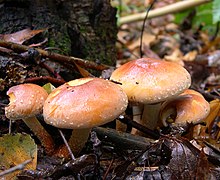| Hypholoma lateritium | |
|---|---|

| |
| Scientific classification | |
| Domain: | Eukaryota |
| Kingdom: | Fungi |
| Division: | Basidiomycota |
| Class: | Agaricomycetes |
| Order: | Agaricales |
| Family: | Strophariaceae |
| Genus: | Hypholoma |
| Species: | H. lateritium |
| Binomial name | |
| Hypholoma lateritium (Schaeff.) P. Kumm. | |
| Synonyms | |
|
Agaricus carneolus Batsch (1783) | |
| Hypholoma lateritium | |
|---|---|
| Gills on hymenium | |
| Cap is convex | |
| Hymenium is adnate | |
| Stipe is bare | |
| Spore print is purple-brown | |
| Ecology is saprotrophic | |
| Edibility is choice but not recommended | |
Hypholoma lateritium, sometimes called brick cap, chestnut mushroom, cinnamon cap, brick top, red woodlover or kuritake, is a fungal species in the genus Hypholoma, which also contains the poisonous species Hypholoma fasciculare and the edible Hypholoma capnoides. Its fruiting bodies are generally larger than either of these. Hypholoma sublateritium is a synonym.
Description
The cap is 3.5–10 centimetres (1+1⁄2–4 in) in diameter, usually with a brick-red coloration in the center and a paler margin. It is smooth, sometimes with red-brown flecks in the middle and sometimes with flaky veil remnants, which can easily be washed off in the rain, on the outside. The gills are crowded, starting yellowish and becoming grayish with age. They do not have the green color of Hypholoma fasciculare. The stipe is light yellow and darker below.
Spores have a germ pore and are 6.0–7.5 × 3.5–4.0 μm. The cheilocystidia are variable; the spore print is purple-brown.
Similar species
It could be confused with highly toxic species such as Galerina marginata or Hypholoma fasciculare.
Distribution and habitat
In Pennsylvania, New Jersey, and West Virginia they are found in dense clusters on stumps and roots from October until long after frosts.
Edibility
Hypholoma lateritium is sometimes considered edible but caution must be taken to avoid confusing it with similar-looking deadly species. In Europe the species is often considered inedible or even poisonous. Specimens are best when collected young; older specimens tend to be bitter from being fouled by insects.
The taste is mild to somewhat bitter, but when cooked the mushrooms have a nutty flavor. They are especially delicious when sauteed in olive oil. Brick tops have been considered one of the better edibles of late fall in the Northeast United States. It is considered a choice edible in Japan.
References
Mostly translated from the German page.
- Facciola, Stephen (1998). Cornucopia II: a Source Book of Edible Plants. Vista, CA: Kampong Publications. p. 254. ISBN 0962808725.
- Stamets, Paul (2005). Mycelium Running: How Mushrooms Can Help Save the World. Berkeley: Ten Speed Press. p. 301. ISBN 1580085792.
- ^ Phillips, Roger (2010). Mushrooms and Other Fungi of North America. Buffalo, NY: Firefly Books. p. 216. ISBN 978-1-55407-651-2.
- McIlvaine, Charles; Macadam, Robert K. (1973). One Thousand American Fungi. New York: Dover. ISBN 0-486-22782-0.
- Miller Jr., Orson K.; Miller, Hope H. (2006). North American Mushrooms: A Field Guide to Edible and Inedible Fungi. Guilford, CN: FalconGuide. p. 245. ISBN 978-0-7627-3109-1.
- Palmer, E. Laurence; Fowler, H. Seymour (1975). Fieldbook of Natural History: Second Edition. New York: McGraw Hill. xviii + 779 pp. ISBN 0-07-048425-2 (Hypholoma sublateritium, p. 86.)
- Cornell Mushroom Blog. http://blog.mycology.cornell.edu/?p=27
- Lincoff, Gary (1995). National Audubon Society Field Guide to North American Mushrooms (11th ed.). pp. 710–711. ISBN 0394519922.
External links
Gallery
| Taxon identifiers | |
|---|---|
| Hypholoma lateritium |
|
This Agaricales-related article is a stub. You can help Misplaced Pages by expanding it. |






